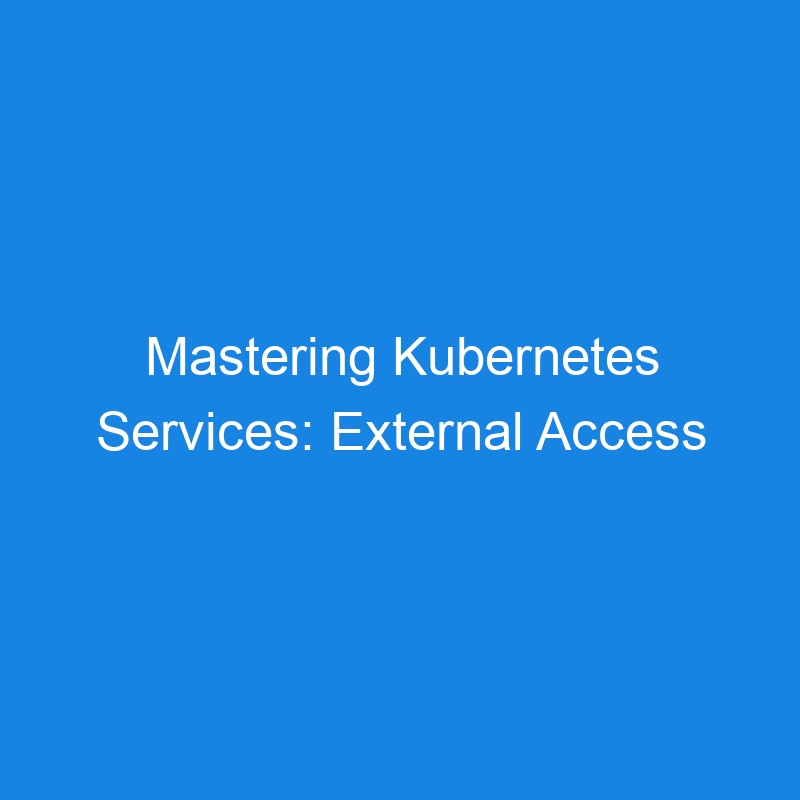Kubernetes Services for External Access and Internal Networking
In Kubernetes, Services play a pivotal role in enabling communication between different components of a cluster and exposing applications to the outside world. They abstract pod networking, offering a stable interface despite the ephemeral nature of pods.
This guide explores Kubernetes Services for both external access and internal networking, detailing types, use cases, and configurations.
What Are Kubernetes Services?
A Service is an abstraction that defines a logical set of pods and a policy to access them. Services provide a consistent way to interact with applications, even as pods are dynamically created, deleted, or replaced.
Key features:
- Stable Endpoints: Services provide a single, stable IP and DNS name to access pods.
- Load Balancing: Distribute traffic across multiple pods.
- Discoverability: Enable internal communication within the cluster.
Types of Kubernetes Services
1. ClusterIP (Default)
- Exposes the Service internally within the cluster.
- Use Case: Communication between internal components (e.g., microservices).
- Accessed via
ClusterIPand port.
Example Configuration:
apiVersion: v1
kind: Service
metadata:
name: internal-service
spec:
selector:
app: backend
ports:
- protocol: TCP
port: 80
targetPort: 8080
2. NodePort
- Exposes the Service on each node’s IP at a static port (30000-32767).
- Use Case: Basic external access for testing or small setups.
- Accessed via
<NodeIP>:<NodePort>.
Example Configuration:
apiVersion: v1
kind: Service
metadata:
name: nodeport-service
spec:
type: NodePort
selector:
app: backend
ports:
- protocol: TCP
port: 80
targetPort: 8080
nodePort: 30007
3. LoadBalancer
- Exposes the Service externally using a cloud provider’s load balancer.
- Use Case: Production-grade external access.
- Accessed via an external IP assigned by the load balancer.
Example Configuration:
apiVersion: v1
kind: Service
metadata:
name: loadbalancer-service
spec:
type: LoadBalancer
selector:
app: backend
ports:
- protocol: TCP
port: 80
targetPort: 8080
4. ExternalName
- Maps a Service to an external DNS name.
- Use Case: Access external services (e.g., databases, APIs).
- No selector or pods involved.
Example Configuration:
apiVersion: v1
kind: Service
metadata:
name: externalname-service
spec:
type: ExternalName
externalName: external.database.example.com
How Kubernetes Services Work
-
Service Discovery:
- Kubernetes automatically assigns a ClusterIP to the Service.
- Pods selected by the
selectorfield are associated with the Service.
-
Endpoints:
- Kubernetes creates a list of pod IPs under the Service’s associated endpoints.
- Use
kubectl get endpointsto view associated pods.
-
Networking Rules:
- Services rely on iptables or IPVS for packet routing within the cluster.
- Traffic is directed to healthy pods using round-robin or other algorithms.
External Access with Ingress and Services
For advanced routing and SSL termination, combine Ingress with Services:
- Ingress acts as a layer-7 HTTP/HTTPS load balancer.
- It routes requests based on paths or hostnames.
Example Ingress Configuration:
apiVersion: networking.k8s.io/v1
kind: Ingress
metadata:
name: example-ingress
spec:
rules:
- host: example.com
http:
paths:
- path: /
pathType: Prefix
backend:
service:
name: backend-service
port:
number: 80
Service Selectors and Labels
Services use selectors to target specific pods based on their labels. This decouples the Service from specific pod instances, enabling dynamic scaling and replacement.
Example:
apiVersion: v1
kind: Service
metadata:
name: label-selector-service
spec:
selector:
app: my-app
tier: frontend
Internal Networking with ClusterIP
ClusterIP Services are essential for internal communication:
- Frontend applications communicate with backend services using DNS names provided by CoreDNS.
- Example: Access a Service named
backend-servicewithhttp://backend-service.
DNS Resolution:
For a Service in the default namespace:
-
http://<service-name>
For a Service in another namespace: http://<service-name>.<namespace>.svc.cluster.local
Advanced Service Configurations
1. Headless Services
- Used when pods need to be accessed directly without load balancing.
- Kubernetes does not assign a ClusterIP.
- Use Case: Stateful applications like databases.
Example Configuration:
apiVersion: v1
kind: Service
metadata:
name: headless-service
spec:
clusterIP: None
selector:
app: stateful-app
ports:
- protocol: TCP
port: 5432
targetPort: 5432
2. Service without Selectors
- Allows custom endpoints (e.g., external IPs or services outside Kubernetes).
- Use Case: Connecting to non-Kubernetes workloads.
Example Configuration:
apiVersion: v1
kind: Service
metadata:
name: custom-endpoint-service
spec:
ports:
- protocol: TCP
port: 80
targetPort: 8080
externalIPs:
- 192.168.1.100
Best Practices
-
Use Labels Consistently:
- Apply consistent labeling conventions across deployments to simplify Service configuration.
-
Monitor Service Health:
- Use tools like Prometheus and Grafana to monitor traffic and ensure availability.
-
Secure Services:
- Restrict external access using Network Policies.
- Use TLS termination with Ingress or a service mesh.
-
Scale with Load Balancers:
- For production-grade external access, prefer LoadBalancer or Ingress configurations over NodePort.
Common Commands for Services
- View Services:
kubectl get services
- Describe a Service:
kubectl describe service <service-name>
- View Endpoints:
kubectl get endpoints
Conclusion
Kubernetes Services simplify networking by abstracting pod communication and providing consistent access mechanisms. Whether you’re enabling internal communication with ClusterIP, exposing applications externally with LoadBalancer, or routing traffic with Ingress, Kubernetes Services offer a flexible and powerful networking solution.
By understanding and leveraging these Service types effectively, you can ensure seamless connectivity and scalability for your applications in Kubernetes.
